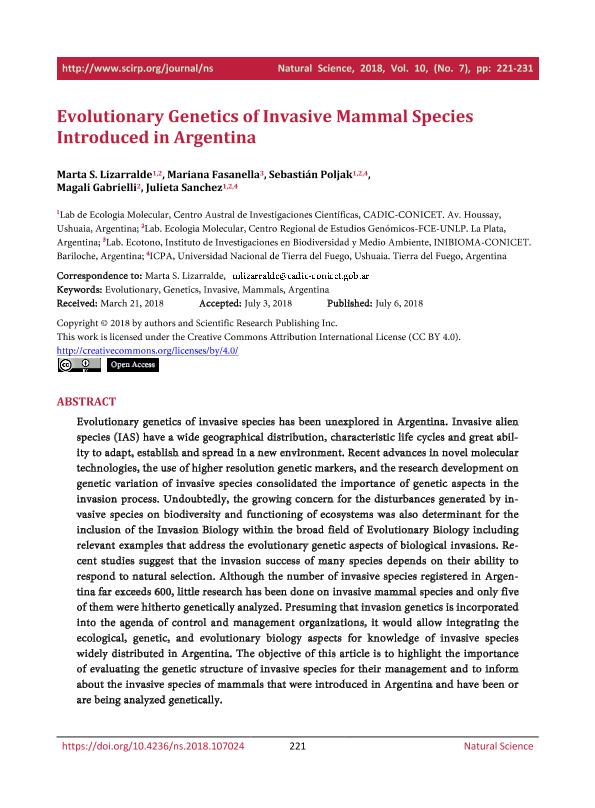Mostrar el registro sencillo del ítem
dc.contributor.author
Lizarralde, Marta Susana

dc.contributor.author
Fasanella, Mariana

dc.contributor.author
Poljak, Sebastián

dc.contributor.author
Gabrielli, Magali

dc.contributor.author
Sánchez, Julieta

dc.date.available
2019-10-18T20:09:25Z
dc.date.issued
2018-07
dc.identifier.citation
Lizarralde, Marta Susana; Fasanella, Mariana; Poljak, Sebastián; Gabrielli, Magali; Sánchez, Julieta; Evolutionary Genetics of Invasive Mammal Species Introduced in Argentina; Scientific Research Publishing; Natural Science; 10; 7; 7-2018; 221-231
dc.identifier.issn
2150-4091
dc.identifier.uri
http://hdl.handle.net/11336/86488
dc.description.abstract
Evolutionary genetics of invasive species has been unexplored in Argentina. Invasive alienspecies (IAS) have a wide geographical distribution, characteristic life cycles and great abilityto adapt, establish and spread in a new environment. Recent advances in novel moleculartechnologies, the use of higher resolution genetic markers, and the research development ongenetic variation of invasive species consolidated the importance of genetic aspects in theinvasion process. Undoubtedly, the growing concern for the disturbances generated by invasivespecies on biodiversity and functioning of ecosystems was also determinant for theinclusion of the Invasion Biology within the broad field of Evolutionary Biology includingrelevant examples that address the evolutionary genetic aspects of biological invasions. Recentstudies suggest that the invasion success of many species depends on their ability torespond to natural selection. Although the number of invasive species registered in Argentinafar exceeds 600, little research has been done on invasive mammal species and only fiveof them were hitherto genetically analyzed. Presuming that invasion genetics is incorporatedinto the agenda of control and management organizations, it would allow integrating theecological, genetic, and evolutionary biology aspects for knowledge of invasive specieswidely distributed in Argentina. The objective of this article is to highlight the importanceof evaluating the genetic structure of invasive species for their management and to informabout the invasive species of mammals that were introduced in Argentina and have been orare being analyzed genetically.
dc.format
application/pdf
dc.language.iso
eng
dc.publisher
Scientific Research Publishing
dc.rights
info:eu-repo/semantics/openAccess
dc.rights.uri
https://creativecommons.org/licenses/by/2.5/ar/
dc.subject
INVASIVE MAMMALS
dc.subject
GENETICS
dc.subject
TIERRA DEL FUEGO
dc.subject
EVOLUTIONARY
dc.subject
ARGENTINA
dc.subject.classification
Genética y Herencia

dc.subject.classification
Ciencias Biológicas

dc.subject.classification
CIENCIAS NATURALES Y EXACTAS

dc.title
Evolutionary Genetics of Invasive Mammal Species Introduced in Argentina
dc.type
info:eu-repo/semantics/article
dc.type
info:ar-repo/semantics/artículo
dc.type
info:eu-repo/semantics/publishedVersion
dc.date.updated
2019-10-10T13:54:00Z
dc.identifier.eissn
2150-4105
dc.journal.volume
10
dc.journal.number
7
dc.journal.pagination
221-231
dc.journal.pais
Estados Unidos

dc.description.fil
Fil: Lizarralde, Marta Susana. Consejo Nacional de Investigaciones Científicas y Técnicas. Centro Austral de Investigaciones Científicas; Argentina. Universidad Nacional de La Plata. Centro Regional de Estudios Genómicos; Argentina
dc.description.fil
Fil: Fasanella, Mariana. Consejo Nacional de Investigaciones Científicas y Técnicas. Centro Científico Tecnológico Conicet - Patagonia Norte. Instituto de Investigaciones en Biodiversidad y Medioambiente. Universidad Nacional del Comahue. Centro Regional Universidad Bariloche. Instituto de Investigaciones en Biodiversidad y Medioambiente; Argentina. Universidad Nacional del Comahue. Centro Regional Universitario Bariloche. Laboratorio de Ecotono; Argentina
dc.description.fil
Fil: Poljak, Sebastián. Consejo Nacional de Investigaciones Científicas y Técnicas. Centro Austral de Investigaciones Científicas; Argentina. Universidad Nacional del Comahue. Centro Regional Universitario Bariloche. Laboratorio de Ecotono; Argentina. Universidad Nacional de Tierra del Fuego. Instituto de Ciencias Polares, Recursos Naturales y Ambiente; Argentina
dc.description.fil
Fil: Gabrielli, Magali. Consejo Nacional de Investigaciones Científicas y Técnicas; Argentina. Universidad Nacional de La Plata. Centro Regional de Estudios Genómicos; Argentina
dc.description.fil
Fil: Sánchez, Julieta. Consejo Nacional de Investigaciones Científicas y Técnicas. Centro Austral de Investigaciones Científicas; Argentina. Universidad Nacional del Comahue. Centro Regional Universitario Bariloche. Laboratorio de Ecotono; Argentina. Universidad Nacional de Tierra del Fuego. Instituto de Ciencias Polares, Recursos Naturales y Ambiente; Argentina
dc.journal.title
Natural Science
dc.relation.alternativeid
info:eu-repo/semantics/altIdentifier/url/https://www.scirp.org/journal/PaperInformation.aspx?PaperID=85843
dc.relation.alternativeid
info:eu-repo/semantics/altIdentifier/doi/http://dx.doi.org/10.4236/ns.2018.107024
Archivos asociados
